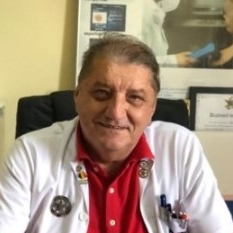Targeted Therapies for Skin Diseases
A special issue of Pharmaceutics (ISSN 1999-4923). This special issue belongs to the section "Drug Targeting and Design".
Deadline for manuscript submissions: closed (30 November 2023) | Viewed by 7220
Special Issue Editors
2. Elias Emergency University Hospital, Bucharest, Romania
Interests: bioactive materials; nanotechnology; targeted therapy; biologic therapy; chronic wounds; wound healing; chronic skin infections; microbial biofilms; skin cancer; melanoma
Special Issues, Collections and Topics in MDPI journals
2. The Research Institute of the University of Bucharest, ICUB, 060023 Bucharest, Romania
Interests: biofilms and tolerance of biofilm-embedded cells; quorum sensing; antipathogenic strategies; human microbiota; probiotics bacterial pathogenesis; virulence factors; biofilms; antibacterial activity; antibiotic resistance; Staphylococcus aureus; Escherichia coli; Pseudomonas aeruginosa
Special Issues, Collections and Topics in MDPI journals
2. The Research Institute of the University of Bucharest, ICUB, 060023 Bucharest, Romania
3. Romanian Academy of Scientists, 050085 Bucharest, Romania
4. The Romanian Academy, 010071 Bucharest, Romania
Interests: bacterial pathogenesis; epidemiology; reservoirs; antimicrobial strategies; microbial virulence; microbial pathogenicity; virulence factors; quorum sensing; biofilms; antibacterial activity; antibiotic resistance; Staphylococcus aureus; Escherichia coli; Pseudomonas aeruginosa
Special Issues, Collections and Topics in MDPI journals
2. The Research Institute of the University of Bucharest, ICUB, 060023 Bucharest, Romania
Interests: microbiology; immunology; new antimicrobial agents; host-pathogen signaling; infection control; antimicrobial nanomaterials; bacterial pathogenesis; virulence factors; quorum sensing; biofilms; antibacterial activity; antibiotic resistance; Staphylococcus aureus; Escherichia coli; Pseudomonas aeruginosa; microbial molecular biology; bioactive materials; nanotechnology; nanoengineering
Special Issues, Collections and Topics in MDPI journals
Interests: psoriasis; inflammatory skin diseases; targeted therapy; biologic therapy; immunology
2. Cantacuzino National Military Medical Institute for Research and Development, 050096 Bucharest, Romania
Interests: infectious diseases; microbiology; chronic infections; bacteriophage; microcalorimetry; tuberculosis; blood-borne pathogens
Special Issues, Collections and Topics in MDPI journals
Interests: chronic wounds; skin cancer; melanoma; inflammatory skin diseases; targeted therapy; biologic therapy; immunology
Interests: skin cancer; melanoma; chronic wounds; inflammatory skin diseases; targeted therapy; biologic therapy; immunology
Special Issue Information
Dear Colleagues,
Over the last few years, the therapeutic landscape of cutaneous pathologies has changed tremendously. Novel diagnostic and therapeutic approaches have developed toward being based on observations resulting from artificial intelligence analysis, the study of biomarkers, and the identification of specific cellular and molecular pathogenic targets. With the emergence of ingenious topical and systemic targeted therapies, higher rates of healing and disease control in skin cancers, chronic infections, wound healing, and inflammatory and autoimmune diseases were achieved. On the other side, a wide range of adverse reactions have emerged (dermatologic or otherwise) that impact treatment outcomes and are difficult to manage, requiring experience and a multidisciplinary approach. Innovation of therapies should focus on the endpoint together with their efficiency and application in clinical practice, achieving the lowest possible cytotoxicity and incidence of adverse reactions.
As an editorial team with clinical and research experience in novel therapies (biologic therapy, Janus kinase inhibitors, immunotherapy, vaccines, drug delivery systems, nanotechnology, bioactive materials, transdermal drug delivery systems), we are pleased to invite you to contribute your recent work to this Special Issue, which aims to bring together the most innovative and interesting advances made in the targeted treatment of skin diseases.
Original research articles and review papers focusing on this intriguing field are welcome to be considered for publication in this Special Issue. We encourage you to submit your research, and this Special Issue may be printed in book format if 10 or more papers are published.
We look forward to receiving your contributions.
Dr. Mara Mădălina Mihai
Prof. Dr. Veronica Lazǎr
Prof. Dr. Mariana-Carmen Chifiriuc
Dr. Alina-Maria Holban
Prof. Dr. Cǎlin Giurcǎneanu
Prof. Dr. Mircea Ioan Popa
Dr. Liliana Gabriela Popa
Dr. Cristina Beiu
Guest Editors
Manuscript Submission Information
Manuscripts should be submitted online at www.mdpi.com by registering and logging in to this website. Once you are registered, click here to go to the submission form. Manuscripts can be submitted until the deadline. All submissions that pass pre-check are peer-reviewed. Accepted papers will be published continuously in the journal (as soon as accepted) and will be listed together on the special issue website. Research articles, review articles as well as short communications are invited. For planned papers, a title and short abstract (about 100 words) can be sent to the Editorial Office for announcement on this website.
Submitted manuscripts should not have been published previously, nor be under consideration for publication elsewhere (except conference proceedings papers). All manuscripts are thoroughly refereed through a single-blind peer-review process. A guide for authors and other relevant information for submission of manuscripts is available on the Instructions for Authors page. Pharmaceutics is an international peer-reviewed open access monthly journal published by MDPI.
Please visit the Instructions for Authors page before submitting a manuscript. The Article Processing Charge (APC) for publication in this open access journal is 2900 CHF (Swiss Francs). Submitted papers should be well formatted and use good English. Authors may use MDPI's English editing service prior to publication or during author revisions.
Keywords
- targeted therapy
- precision medicine
- biologic therapy
- Janus kinase inhibitors
- immunotherapy
- vaccines
- drug delivery systems
- antimicrobials
- nanotechnology
- bioactive materials
- transdermal drug delivery













